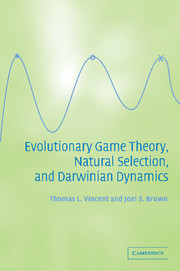Book contents
- Frontmatter
- Contents
- List of figures
- Preface
- 1 Understanding natural selection
- 2 Underlying mathematics and philosophy
- 3 The Darwinian game
- 4 G-functions for the Darwinian game
- 5 Darwinian dynamics
- 6 Evolutionarily stable strategies
- 7 The ESS maximum principle
- 8 Speciation and extinction
- 9 Matrix games
- 10 Evolutionary ecology
- 11 Managing evolving systems
- References
- Index
2 - Underlying mathematics and philosophy
Published online by Cambridge University Press: 11 August 2009
- Frontmatter
- Contents
- List of figures
- Preface
- 1 Understanding natural selection
- 2 Underlying mathematics and philosophy
- 3 The Darwinian game
- 4 G-functions for the Darwinian game
- 5 Darwinian dynamics
- 6 Evolutionarily stable strategies
- 7 The ESS maximum principle
- 8 Speciation and extinction
- 9 Matrix games
- 10 Evolutionary ecology
- 11 Managing evolving systems
- References
- Index
Summary
Darwin used lengthy, sometimes discursive, yet convincing, verbal arguments in his Origin of Species. Darwin's postulates, as discussed in Chapter 1 and upon which his theory is built, apply broadly to the explanation or understanding of evolution. However, as verbal concepts they are limited to persuasion with few formal predictive capabilities. For example, one can understand why Darwin's finches have particular beak characteristics (Weiner, 1994). One can even predict that natural selection will tend to increase beak size during periods of drought. However, one cannot use verbal Darwinian arguments to predict the exact beak size appropriate to a particular species of finch. In fact, the ability to make such a prediction based on pure Darwinian principles is impossible unless these principles can be translated into a mathematical language. Only then can his theory be used not only to explain, but also to make predictions. Furthermore, without a mathematical framework, it is difficult or impossible to understand how a trait such as cooperation evolves.
Making Darwin's theory rigorous and predictive has been an achievement of population genetics and quantitative genetics approaches to evolution. These approaches often get bogged down in the genetic details and, consequently, lose a sense of the ecological interactions that take place to determine evolution by natural selection. Furthermore, while the genetic approach may determine those “selfish” genes that are propagated through time, it is the trait that the genes code for that actually is selected.
- Type
- Chapter
- Information
- Publisher: Cambridge University PressPrint publication year: 2005



